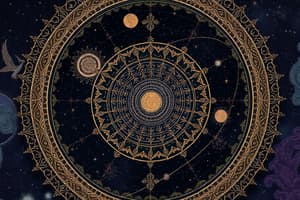Podcast
Questions and Answers
What did Galileo develop in terms of motion, and how did he use inclined planes to do so?
What did Galileo develop in terms of motion, and how did he use inclined planes to do so?
Galileo developed the concept of motion in terms of velocity (speed and direction) and used inclined planes to demonstrate this concept.
What is the natural state of an object according to Galileo's laws of motion?
What is the natural state of an object according to Galileo's laws of motion?
The natural state of an object is rest or uniform motion.
What force does Galileo attribute to the eventual stopping of objects in motion?
What force does Galileo attribute to the eventual stopping of objects in motion?
Friction
What would happen to a ball rolling horizontally if there were no friction, according to Galileo's hypothesis?
What would happen to a ball rolling horizontally if there were no friction, according to Galileo's hypothesis?
What did Galileo attribute the difference between initial and final heights to, in his experiment with inclined planes?
What did Galileo attribute the difference between initial and final heights to, in his experiment with inclined planes?
What is the dual property of light, and how does it behave in each of these forms?
What is the dual property of light, and how does it behave in each of these forms?
What is the cause of refraction, and how does it relate to light particles?
What is the cause of refraction, and how does it relate to light particles?
What is the photo-electric effect, and how does it demonstrate the particle-like behavior of light?
What is the photo-electric effect, and how does it demonstrate the particle-like behavior of light?
What is diffraction, and how does it relate to the wave-like behavior of light?
What is diffraction, and how does it relate to the wave-like behavior of light?
How does light behave when it travels through materials of different refractive indices, and what is the resulting phenomenon?
How does light behave when it travels through materials of different refractive indices, and what is the resulting phenomenon?
What is the relationship between the frequency of light and the energy of its photons?
What is the relationship between the frequency of light and the energy of its photons?
How do light waves behave when they impact a smooth, specular surface, such as a mirror?
How do light waves behave when they impact a smooth, specular surface, such as a mirror?
What happens when a beam of light travels from one medium to another with a different refractive index?
What happens when a beam of light travels from one medium to another with a different refractive index?
How do particles of light behave when they pass from one medium to another?
How do particles of light behave when they pass from one medium to another?
What type of mirror has a perfectly flat surface with no distortions and reflects 100% of the light that strikes it?
What type of mirror has a perfectly flat surface with no distortions and reflects 100% of the light that strikes it?
What happens to the wavefronts when a beam of light passes from one medium to another?
What happens to the wavefronts when a beam of light passes from one medium to another?
What is the result of light reflecting off a smooth surface, such as a mirror?
What is the result of light reflecting off a smooth surface, such as a mirror?
Flashcards are hidden until you start studying



